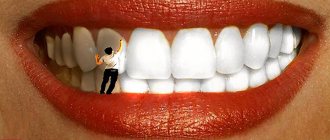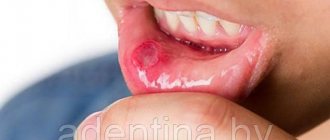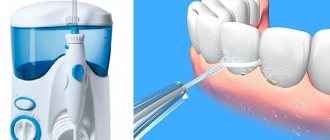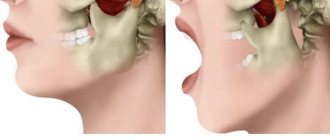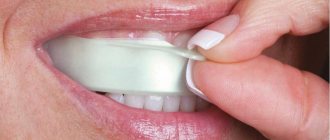Reasons for discoloration of extended teeth
The situation when the extended tooth turns yellow several years after a visit to the dentist is quite normal. Most often this is due to the quality of the materials with which the doctor performed the extension. As a rule, these are composites. They tend to accumulate odors and dyes. In addition, if they are not polished every 3-4 months, they lose their smoothness, become rough and “cling” to plaque even better, and also absorb various pigments.
Important! The extended tooth requires very careful hygienic care and also requires adherence to a certain diet, which is especially important when the restoration is performed in the frontal area of the smile. Otherwise, after a short period of time you may notice that it is different in color from the rest.
A bad habit such as smoking can cause a quick change in the shade of the restoration.
Darkening can also be caused by other serious circumstances: trauma, development of secondary caries, pulp necrosis, incorrectly or poorly treated root canals. However, then, in addition to the change in shade, you will probably be bothered by other unpleasant symptoms, for example, pain. And here the first goal will not be bleaching, but treatment. To do this, you need to seek professional help as quickly as possible.
If before the extension the doctor removed the nerve and treated the canals, then the darkening of the enamel is associated precisely with depulpation, because the tooth was deprived of its source of vital nutrition, it became “dead,” fragile and susceptible to any negative factor from the outside. A tooth can also darken from the inside due to filling the canals with resorcinol-formalin paste.
The reason that the cured one stands out in color from the rest may also be the method of its restoration. For example, if the extension was carried out on a metal pin, then the rod may be visible through the restoration materials.
What contributes to the darkening of crowns and dentures
It is not only the appearance of artistic restorations and fillings made using composite materials that causes dissatisfaction among patients in dental clinics. Some complain that they are not satisfied with the color of prosthetic structures made from metal-ceramics or plastic. Why is this happening?
Plastic products are similar in aesthetic and quality characteristics to those made from composites. The material is very “delicate”, it is porous, and quickly loses its aesthetics under the influence of food and drinks with dyes, from smoking, and due to lack of oral hygiene.
Metal-ceramic prostheses are a different story. And if you are going to install them in the smile area, which professional doctors strongly do not recommend doing, then you must have a clear understanding of their shortcomings:
- the metal shines through the ceramics: if the restoration is single, then this will be noticeable, especially in bright lighting,
- the metal oxidizes, so a bluish rim may appear at the border with the gum over time, which will further spoil the overall impression of your smile.
Important! In order not to think about the question of how to whiten artificial crowns and dentures installed in the smile area, initially choose the right materials from which they will be made. Ceramics and zirconium dioxide are ideal for the smile area: they do not change shade throughout their entire service life and have high aesthetics.
How to preserve the color of artificial teeth?
Prosthetic structures retain their color and texture for a long time only with careful care and handling. To maintain aesthetic characteristics you should:
- Clean dentures after all meals. Each time you need to thoroughly rinse the structures under running water.
- Do not use whitening toothpastes with abrasive particles for cleaning. Under their influence, scratches are formed on the surface, which subsequently accumulate plaque.
- Use special products for cleaning and disinfection once a week. Most often they are sold in the form of tablets that dissolve in water.
- Avoid drinking colored drinks and foods. Coffee, tea, colored juices and berries can leave stains on dentures.
- Avoid strong changes in temperature in the oral cavity. They can lead to loosening of the construction material and darkening of its color.
- Stop smoking. Nicotine worsens the color of not only natural teeth, but also dentures.
If it is not possible to return the original color of artificial teeth, it is better to take the removable module to the clinic for professional cleaning. There the original appearance of the structure will be quickly restored. Or at least they will remove plaque and stains that the patient could not cope with on his own.
Is it possible to whiten restorations at home or in dentistry?
How to whiten an extended tooth at home or in dentistry? The answer will disappoint many. This is impossible to do for the reason that all bleaching agents known today act only on organic tissues (i.e. directly on enamel and dentin), destroying the pigment in them.
On a note! Patients who have removable dentures also often wonder if they can be whitened. It is impossible to do this. It is much easier to prevent darkening of materials by promptly removing food and bacterial plaque from them: cleaning tablets and professional hygiene at the dentist will help with this.
However, if the extended tooth has darkened due to depulpation, i.e. If the nerve is removed, you can try to restore its color using intracanal bleaching performed in the dentist’s office. However, it is worth remembering that the procedure can make it even more fragile and weak. It may even break off over time, which will lead to the need for removal. In addition, the effect will only be temporary; in 1-2 years everything can return to its place.
Negative consequences of bleaching artificial materials
When carrying out artistic restorations and prosthetics, doctors try to choose a color that matches as closely as possible the natural shade of the patient’s enamel. However, over time, both the natural enamel and the restorations themselves can darken. That's why many people think about whitening. But at the same time, not everyone is ready to take the word of the dentist that this is impossible. Some people try to do lightening at home, for example, using highly abrasive bleaching pastes, soda, hydrogen peroxide, and store-bought gels. What negative consequences can this lead to?
- neighboring teeth will become lighter, but the restoration will not change its color and will look even darker against the general background,
- Cracks, scratches and chips will appear on artificial materials: bleaching compounds aggressively affect not only the enamel, but also the restorations, they can damage them and significantly reduce their service life. Remember that the resulting cracks are secluded places for the accumulation of bacteria that provoke dental diseases.
A number of researchers1 have found that bleaching agents can destroy the strength and hardness of artificial materials and contribute to the formation of roughness on them. Moreover, products made from some materials, for example, methyl methacrylates, can become orange after exposure to peroxide and urea, and amalgam fillings can become toxic. Designs made of gold and porcelain are subject to the least negative impact.
Teeth whitening ZOOM
ZOOM teeth whitening was performed by dental hygienist Elena Smirnova, a certified zoom teeth whitening specialist. Before teeth whitening, the gums are protected with a special product that is not washed off with saliva so that the whitening gel does not get on the mucous membrane and cause irritation. Relief® gel is applied to the teeth for 5 minutes to reduce enamel sensitivity. It is then removed and whitening gel is applied. The whitening gel is activated using a special ZOOM lamp. Each cycle of application of the bleach product produces a slight brightening. The specialist carefully compares the achieved result with the selected tooth color using a special color scale. After the last cycle, the protective agent is removed from the gums. The procedure lasts 2 hours, while the teeth whitening itself takes 45 minutes, and the rest of the time is required to protect the gums and cleanse the teeth of all products after the whitening is completed.
The result of teeth whitening before artistic restoration:
What can be done with darkened restoration
If your extended tooth turns black, there may be several options for solving the problem. All of them can be done with the help of a dentist.
Artistic extension
Patients who have teeth made of composite materials often complain of a rapid loss of smile aesthetics. However, they have the advantage that such a restoration can always be replaced with a new one. The doctor can easily grind off the old composites and apply fresh ones that will match the color. All this can be done in one visit to the clinic, and you won’t have to burden yourself with big expenses. The asking price is from 5 thousand rubles.
On a note! Has the composite material used for the extensions become dull and lost its shine? Perhaps polishing and sanding it will be enough. If you contact your dentist for this service every 3-4 months, the restoration will retain its beauty longer.
Installation of veneers or lumineers
The thinnest ceramic or zirconium dioxide plates will make your smile beautiful not for 2-3 years (as with composite restoration), but for 10 years or more. At the same time, the linings will not change their color under the influence of pigments from food and drinks, and will not lose their shine and whiteness throughout the entire period of use.
It is worth noting here that it is better to install onlays of this type on all teeth located in the smile zone at once, because otherwise they may stand out against the general background. And then it will seem that the neighboring teeth are darker than the one that was restored.
“The tooth added to the front has darkened. In principle, this was expected, because... The doctor warned that sooner or later such a problem would happen. I decided to replace it with Lumineers, but I was very upset when I learned that Lumineers can only be installed as a set, in the amount of 6-8 pieces at once, and this is a very expensive pleasure. And wait several months. After all, the originals have to be ordered from America itself. In the end, I limited myself to a couple of veneers - it turns out that it’s possible. It was really cheaper and looks really nice!”
Christina, fragment of review from otzovik.com
3, Crown installation
To avoid having to think about bleaching and constantly redoing the restoration, you can install a crown made of ceramics or zirconium dioxide. These materials are optimal for the smile area: they have the shine and color of natural enamel, retain their whiteness and performance characteristics for 10 years or more.
This option is best considered for patients whose teeth are severely damaged.
“Five years ago, I fell on the street in icy conditions and suffered a jaw injury; one front tooth, which was built up with a composite due to a slight curvature, was also broken. He had to be depulped. Then I wanted to restore it: for example, to build it up again or put in a veneer, but the doctor said that this was contraindicated, because it is now very fragile, and over time it will begin to darken due to the lack of nerve and the blackness will show through, so it is better to immediately protect it with a crown. We chose ceramic. It looks like it can’t be distinguished from the others by its color, and after years its appearance doesn’t change at all, although I don’t particularly limit myself in anything - I eat and drink whatever I want.”
Alisa Talalueva, review from 32top.ru
After teeth whitening
After using any teeth whitening systems, there are general recommendations: do not consume staining foods and drinks, do not smoke, and do not consume highly acidic foods. These recommendations must be observed especially strictly in the first days, when the top layer of enamel is being restored. Following the recommendations will preserve the whitening results for a long time.
After teeth whitening, the patient plans aesthetic restoration of the front teeth - replacing the old filling and straightening the incisal edge of the tooth.
What to do if your teeth still need to be whitened: what will happen to the restoration?
Do you have an extended or prosthetic tooth in the frontal area, but still want a snow-white smile? Then the sequence of actions should be as follows:
- contact your dentist for professional oral hygiene, removing bacterial plaque and deposits,
- undergo a whitening procedure, professionally, of course. Or the doctor may recommend wearing mouth guards with an individually selected concentration of the active substance in the gel at home, but then the result will become noticeable only after several weeks,
- replace old fillings, restorations or crowns with new ones: at the manufacturing stage, specialists will select a color for them that will match the new shade of the enamel that has been whitened.
Remember that any other sequence of actions is not acceptable. It is not advisable to change the restoration before bleaching, because Each patient is individual and it is unknown what shade the remaining teeth will take after the procedures.
Important! If you have had your teeth whitened and then do not try to maintain the result, you may encounter an unpleasant situation: after a few months they will begin to darken, and the newly grown or restored tooth will already look lighter against their background.





